Termites are sneaky and can go unnoticed for years.
They hide behind walls and soils, making any signs of infestation challenging to identify.
That said, they are not impossible to detect.
You can identify termite infestation as long as you know what to look for.
In this post, we’ll go over all the signs that termites leave behind. So you can get rid of them before it’s too late.
Let’s dive in.
1. Flying Termites or Swarmers
Flying termites, also known as Alates, are typically the first sign of termite infestation.
Most termites hide inside the wood or soil. But you will see flying termites out in the open during a swarm.
“Swarming” describes an event where mass termites gather to mate and start a new colony.
Alates are future kings and queens.
They fly to leave the nest and start new colonies.
If you see a tiny insect with wings inside your home, stop and take a closer look.
If it’s a termite, take immediate action and determine how they got inside.
Flying termites don’t travel far.
So, if you see flying termites, that means there’s a mature colony inside your home or near you.
See if there is a swarm outdoors.
If you have an open window or door, they might have just stumbled into your home.
If no entry points or no swarm are happening outside, you likely have an infestation inside your house.
Termite colonies don’t begin producing flying termites (swarmers) until they are mature, typically after 3-4 years.
That means that the infestation in your home is large and needs to be addressed immediately.
2. Discarded Wings
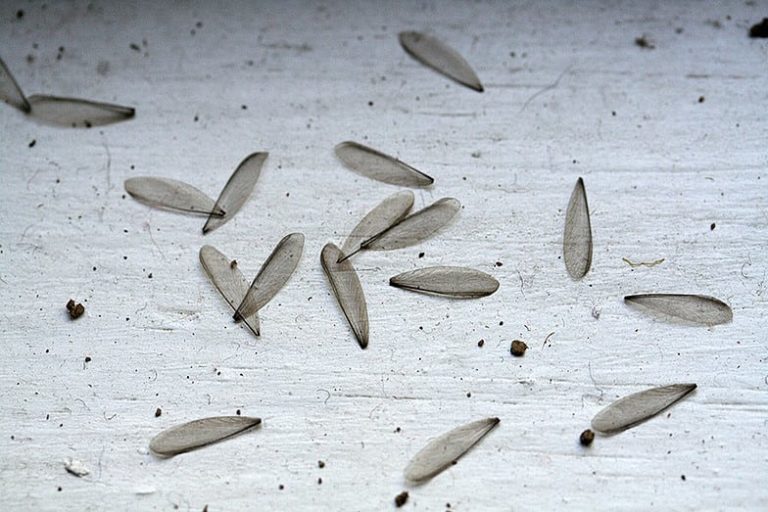
Swarms don’t last long.
And once the mating is over, flying termites lose their wings.
In some cases, discarded wings are one of the only signs that a swarm happened.
If you see discarded wings, it means there’s a mature colony nearby, expanding.
And if you see piles of wings present in your home, you likely have an infestation.
Flying termites are attracted to light.
If the swarm happened indoors, you’d typically see discarded wings near your window and doors.
Outdoors you’ll find them on windowsills, decks, patios, and near the soil.
3. Dead Alates
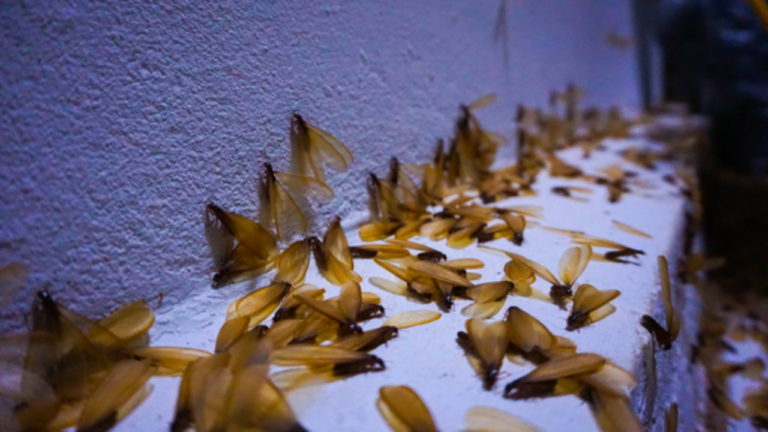
Seeing dead flying termites, a.k.a alates, inside your home is not a sign that a termite population is dying.
It’s the opposite.
Flying termites are a sign that a mature colony is ready to expand.
These termites swarm to leave the nest, reproduce and start a new colony.
But most alates are expected to be unsuccessful in finding a place to start a new colony.
And those who fail to find a place to stay will die quickly from dehydration.
Alates are especially unsuccessful when swarming indoors. But their survival rate is still low even if they mate outdoors.
4. Mud Tubes
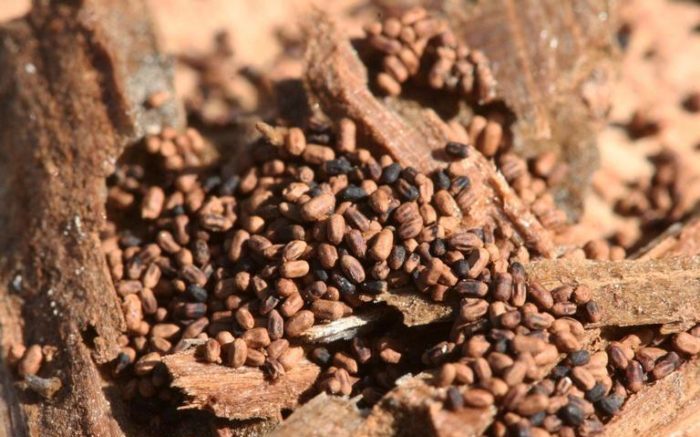
A mud tube is made of subterranean termite droppings, soil, saliva, and wood.
These tubes help Subterranean termites to travel safely
between a food source and the nest.
They are typically the first indication of Subterranean termites infestation.
Mud tubes take on different forms: working tube, exploratory tube, and drop tubes.
Working Tube
Termites use a working tube to travel from their nests to food sources.
These mud tunnels look like veins running up against your wall.
They work similarly to highways.
The termites use some lanes to carry food and others for construction and repair.
Exploratory Tube
Termites use exploratory tubes to search for food sources.
They typically extend from the soil and are not connected to any wood.
Drop Tube
Drop tubes look like calcium deposits that hang in caves. Except they hang from the ceiling.
Subterranean termites use drop tubes to make food sources more accessible and to re-connect with working tubes and the ground.
5. Pallets/ Frass
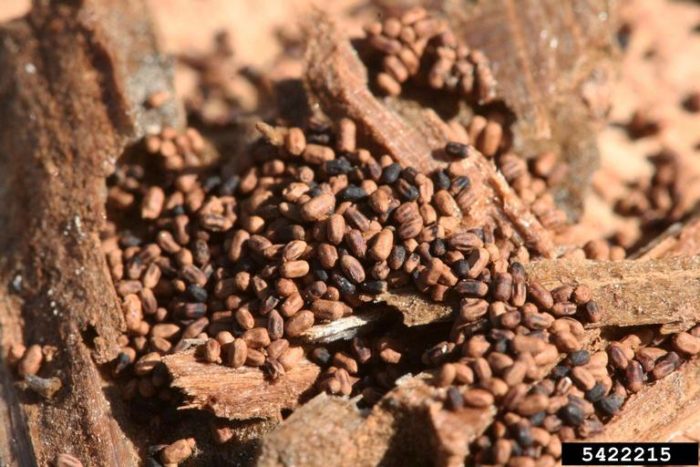
Pellets or frass are a sign of Drywood termite infestation.
Drywood termites produce small, dry droppings called pellets or frass.
Pellets look a lot like sand or sawdust.
But unlike sand, pellets have six concave surfaces.
Drywood termites pellets are hard, elongated, and less than 1/25 inch long.
These pellets vary in color based on the color the termites are consuming.
Drywood termites use “kick out” holes to remove pellets from their tunnels.
If you have an infestation, you may find small piles of pellets on doors, windows, floorboards, and under your furniture.
You may also find them around eaves and joints inside attics and basements.
If you have wooden patios or decks, check the base and corners for any signs of termite droppings.
6. Patches
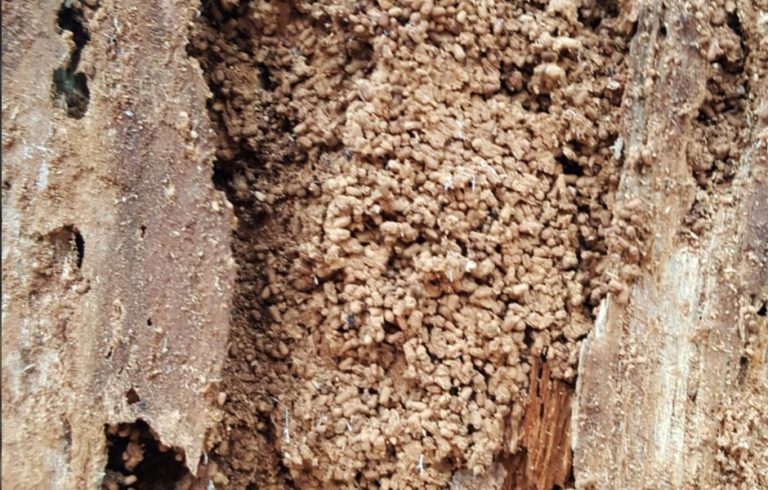
Like Drywood termites, Dampwood termites also produce pellets.
But unlike Drywood termites, Dampwood termites do not expel their pellets into “kick out” holes.
Instead, they use their pellets to protect their nest.
In particular, they use it to seal entry points from the outside world.
As a result, you won’t often find damp wood termites pellets lying around.
The easiest way you’ll find Dampwood droppings is on damaged wood.
The damaged wood will typically have holes with a cover that looks like soft concrete.
The coverage is often imperfect, so it’s easy to identify.
You’ll most likely see Dampwood termites and pellets near water or moist areas.
Some common places to find Dampwood droppings in your home are your shed, deck, basement, porch, and outdoor furniture.
You may also find them under sinks, tubs, or near water hoses.
7. Hollow Wood
Other than visual clues, you can also listen for evidence of termites.
You can tap the wood with your knuckles or a tapping tool and listen for empty sounds.
Termites devour wood from the inside out, leaving a weak shell.
As such, when you knock on an area that has termite damage, it will sound hollow.
The larger the infestation, the more empty the wood will sound.
Excellent places to start tapping are your floors, walls, door frames, window seals, and baseboards.
8. Noises in your walls
Sometimes you’ll be able to hear them eating if you place your ear against your walls.
You can also knock on your walls and listen for quiet clicking sounds.
Soldier termites produce this sound when they bang their heads on wood or shake their bodies.
They do this to warn the other termites of an incoming threat.
9. Bubbling paint
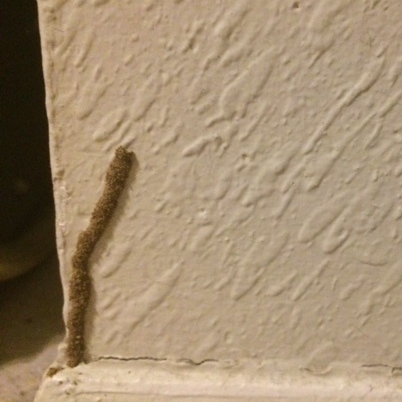
If you notice blisters or bubbles on your painted walls or floors, you might be dealing with a termite infestation.
Termites seal cracks in wood to create the ideal high humidity environment.
This moisture causes paint to form a bubble.
Termites also cause paints to flake or bubble because they feed right up to it. Once they reach the paint, they stop eating.
Bubbling paint is especially common on wood flooring, frames, and paneling.
If you don’t have termites, you could have other problems, like water or moisture damage.
10. Damaged Wood
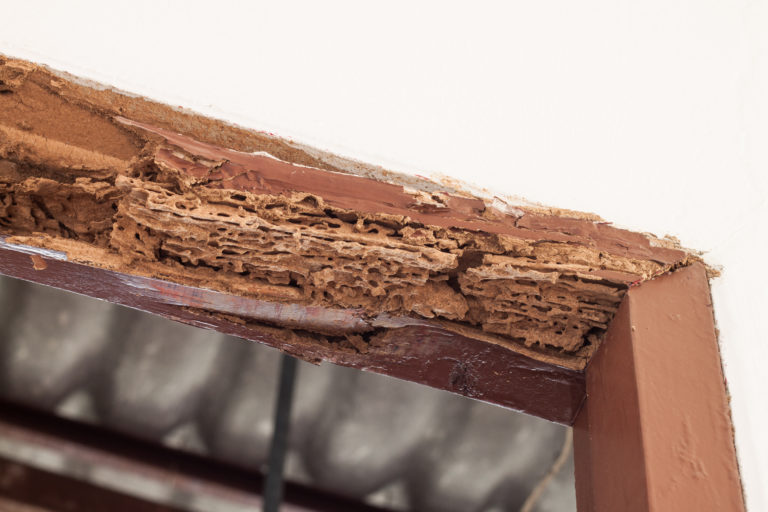
Wood damage is typically only noticeable in severe infestations.
When termites feed on wood, they leave it looking hollow or caved in.
Sometimes, the damage will be so extensive that you’ll see the termite tunnels inside.
You may also notice rotting wood on termite-infested areas.
That’s because termites introduce moisture to the wood when they feed on it.
As a result, termite-infested wood is more vulnerable to rotting.
You may recognize this type of damage on your boards, railing, and paneling.
Termites also damage the structural integrity of the wood.
As a consequence, you may notice load-bearing structures begin to crack.
11. Hard To Open Doors and Windows
Termites love humid environments.
To make sure they have it, they seal cracks and holes on the wood with their droppings.
In doing so, they can trap heat and moisture around them.
As a consequence of the trapped heat and moisture, termite-infested wood tends to warp.
This warping makes it difficult to open termite-infested doors and windows.
If you’re having difficulty opening your doors and windows, look around for any other signs of termite infestation.
12. Termite Cement
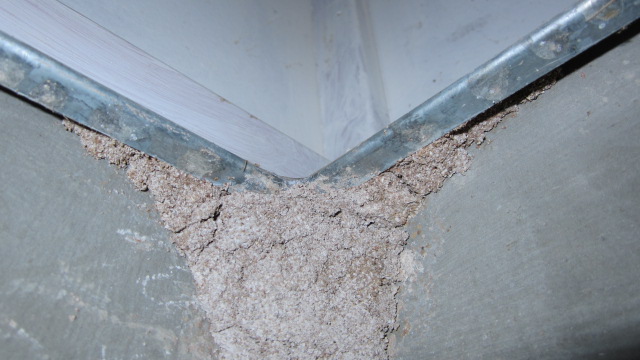
Termites seal cracks with their droppings to create the perfect moist environment.
To do this, they turn their droppings into a mud-like cement.
This cement is pretty easy to spot because they stand out against wood.
They are imperfect in both texture and color relative to the wood around it.
13. Landscape or Tree Damage
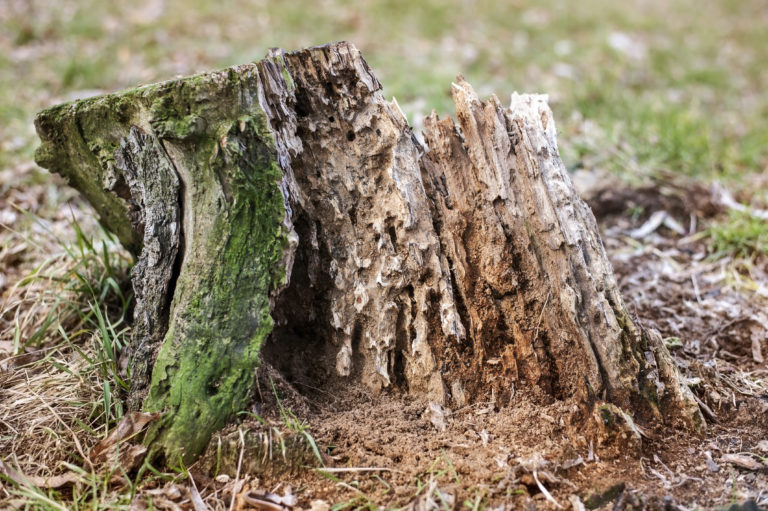
Look for signs of termite damage on trees outside your home.
Inspect the base of the tree for any small holes or wood shavings.
Also, poke around the roots using a shovel and check for any discarded wings or termite carcasses.
If you find evidence of termites, take immediate action.
Termite-infested trees can be dangerous. The termites can make the tree bark hollow enough that it’s vulnerable to falling.
Tree infestation also puts your house at risk of getting infested.
It’s much better to prevent the termites from getting into your house than dealing with them once they’re inside.
Frequently Asked Questions (FAQ)
What is the first sign of a termite infestation?
Flying termites, also known as Alates, are typically the first sign of termite infestation.
That’s because most termites hide inside the wood or soil.
Flying termites, on the other hand, will go out in the open during a swarm.
“Swarming” is an event where mass termites gather to mate and start a new colony.
If you don’t see them flying, you may see their discarded wings.
Swarms don’t last long.
Once the mating is over, flying termites lose their wings.
In some cases, these discarded wings are only signs that a swarm ever happened.
If you see discarded wings, it means there’s you’re near an expanding, mature termite colony.
Another common early sign of an infestation is mud tubes.
Mud tubes are typically the first indication of Subterranean termites infestation.
These termites use these tubes to travel safely between a food source and the nest.
Mud tubes take on different forms: working tube, exploratory tube, and drop tubes.
Working and exploratory tubes look like veins running up against your wall.
Drop tubes look like calcium deposits that hang in caves.
What Does Termite poop look like?
Termite poop varies in appearance depending on the species of termites.
There are three common forms they can take: Pellets, Mud tubes, and Patches.
Termite Pellets or Frass
Pellets, a.k.a frass, are hexagonal, egg-shaped granules.
They look like sand or coffee ground.
Mud Tubes
A mud tube is made of termite droppings, soil, saliva, and wood.
These mud tunnels take on different forms: working tube, exploratory tube, and drop tubes.
The working tube and exploratory tube look like veins running up against your wall.
Drop tubes look like calcium deposits that hang in caves. Except they hang from the ceiling.
Patches or Seals
Patches or Seals are mud-like cement. Termites use them to seal cracks and holes on the wood.
Can I treat my home for termites myself?
The short answer is yes. But only if you have a minor infestation.
Here are three methods you can take to eliminate termites yourself.
Wood Replacement
Wood replacement involves replacing the infested wood.
Wood replacement is ideal if the infestation is only on a few pieces of wood that’s easy to access.
After replacing the wood, treat the new wood bora-care to prevent termites from coming back.
Localized Dust / Foam Treatment
Localized Dust or Foam Treatment involves injecting pesticides into the infested wood.
These pesticides can come in the form of liquid, dust, or foam formulations.
Bait
Bait treatment involves placing toxic bait into the ground around your home.
The termites will ingest the bait and take it to the other members of the colony.
Bait has a delayed effect which allows for termites to spread the bait to other members of the colony.
This method is extremely effective against subterranean termites.
Soil Treatment
Soil treatment involves pouring a liquid insecticide around and under the foundation of your home.
The insecticide will create a barrier against termites.
Any termites that eat or tunnel through the tunnel will die.
How much does termite treatment cost?
Termite treatment costs can vary based on the type of treatment, the size of the house, and where you live.
The average price per square foot is between $1 and $3 for termite fumigation.
Localized treatment can cost anywhere from $300 – $1000 depending on the severity of the situation and method used.
Are termites hard to get rid of?
Yes.
Termites are one of the hardest pests to eliminate.
For one, they can populate very fast.
Their queen can lay millions of eggs each year.
Also, termites are tiny. They can be as small as 2mm.
Meaning, they can crawl and hide into the smallest gaps and crevices in your home to live and breed.
Finally, termites live inside the wood or soil.
They are sneaky and can go unnoticed for years. Any signs of infestation can be challenging to identify.
It’s not uncommon for termites to cause severe damage to your home before you notice that they are there.
Signs of termites infestation can be challenging to identify.
Finally, if you have a significant termite infestation, it’s unlikely that you can eliminate them from your home.
Severe termite infestation requires the help of a professional pest control company.
This process can be costly and time-consuming.
How to Inspect for Termite Activity?
Unfortunately, there are no standard devices that make it easy to detect termites.
The most common way to inspect for termites is to look for visual signs.
To do this, you can use a metal probe, screwdriver, or a knife to probe wood for termite galleries.
Use a flashlight and inspect the damaged wood.
You can also tap the wood with your knuckles or a tapping tool and listen for hollow sounds.
Some ideal places to check are:
- Basement
- Crawlspace
- Subfloors and support posts
- Window and door frames.
- Steps
- Porches
- Trees and outdoor Fence
What are the Signs of Termites in Drywall?
Some common signs of termite-infested drywall include:
- Bubbling or blistered paint.
- Small holes or kick-out holes.
- Baseboards that easily crumble.
- Faint vein-like markings on drywall. These lines are imprints of termite tunnels inside the wall.
- A hollow sound when you tap on the wall.
- Discoloration.

1 thought on “Top 13 Signs You Have Termites”